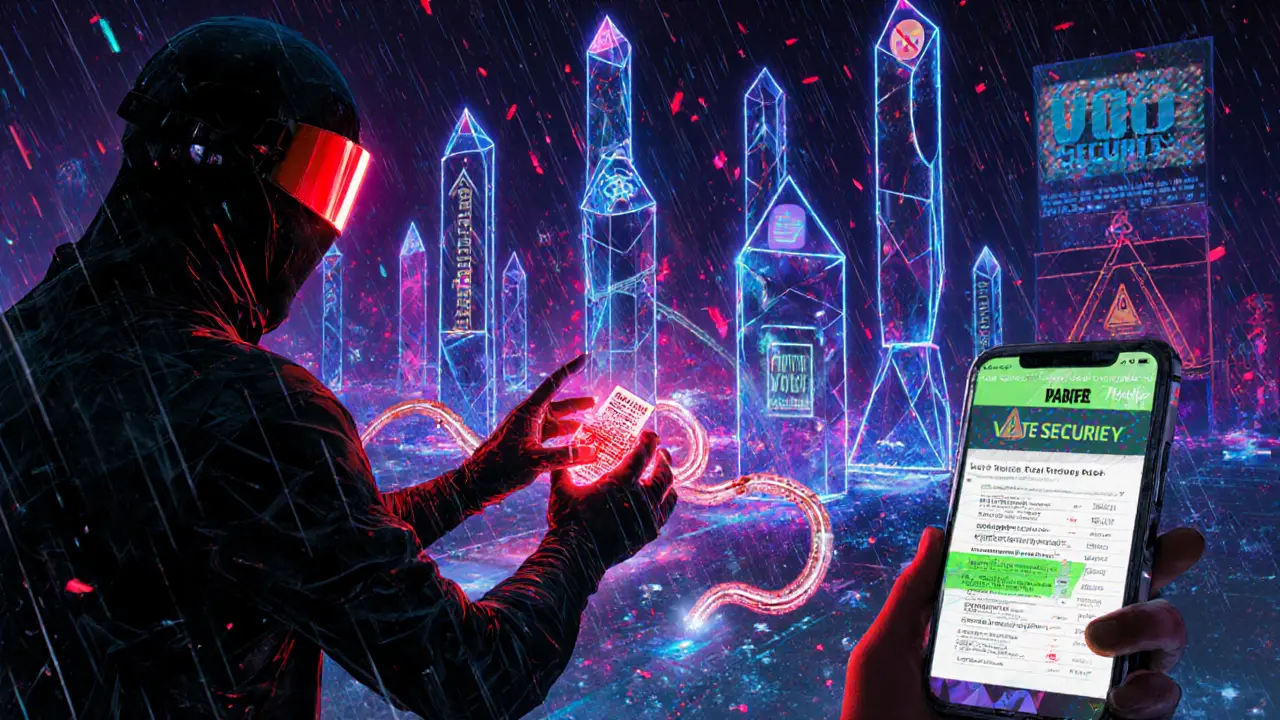Blockchain Voting Adoption Challenge Calculator
This tool helps estimate how likely it is that blockchain voting will succeed in your jurisdiction or context based on key challenges and current mitigation efforts.
Adoption Likelihood Assessment
Key Challenges Overview
Regulatory Uncertainty
Lack of clear legal frameworks delays adoption.
High ImpactSecurity Risks
Device-level malware and network attacks threaten integrity.
High ImpactScalability
Public blockchains struggle with large voter bases.
Medium ImpactTrust & Education
Voter skepticism and lack of understanding hinder adoption.
High ImpactPrivacy Balance
Ensuring transparency while protecting anonymity is complex.
Medium ImpactFinancial Barriers
High upfront costs make it difficult for governments to adopt.
High ImpactImagine casting your ballot from a smartphone, knowing every vote is recorded on an immutable ledger that anyone can audit. That promise fuels the hype around blockchain voting. Yet, despite all the buzz, real‑world elections still rely on paper slips and punch cards. Why? Below is a quick snapshot of the biggest roadblocks.
TL;DR
- Regulators worldwide lack clear rules for blockchain‑based elections.
- Malware on personal devices can hijack votes before they hit the ledger.
- Scaling a national vote on a public blockchain is still expensive and technically tough.
- Voters need simple, trustworthy interfaces - and most don’t have them yet.
- Balancing transparency with anonymity requires advanced cryptography.
Regulatory and Legal Hurdles
Regulatory compliance is the set of laws and standards that election systems must obey, ranging from data‑privacy rules to audit requirements. In the European Union, the General Data Protection Regulation (GDPR) forces any voting system to keep personal data private while still proving that each ballot is valid. Blockchain’s permanent records clash with the "right to be forgotten" principle, leaving lawmakers uneasy.
Many jurisdictions simply haven’t written rules for decentralized voting. The United States, for example, treats each state as a separate election authority, and only a handful have drafted any guidance on using distributed ledgers. Without a clear legal pathway, election officials risk lawsuits or international criticism if something goes wrong.
Interoperability adds another layer of complexity. A blockchain platform that satisfies German electoral law might violate California’s voter‑identification statutes. Until a common framework emerges, cross‑border or even multi‑state pilots remain rare.
Technical Security Vulnerabilities
Security is the word on everyone’s mind, and for good reason. While the blockchain itself is tamper‑resistant, the devices that feed data into it are not. Malware is malicious software that can alter or delete data on a computer or mobile device without the user’s knowledge can change a voter’s choice before the transaction is signed, or it can silently discard the ballot altogether.
State actors have demonstrated the ability to flood election servers with botnet traffic, effectively denying service to legitimate voters. In 2000, a botnet attack in Arizona slowed down vote reporting, illustrating that network‑level attacks are a real threat even before blockchain enters the picture.
Another subtle risk is the manipulation of consensus nodes. If an adversary controls enough nodes in a permissioned network, they could rewrite transaction ordering or censor votes. This scenario, while technically demanding, is not impossible for well‑funded nation‑state actors.
Scalability and Infrastructure Costs
Running a blockchain for a small corporate board is cheap; running one for 50million voters is a different story. Current public blockchains struggle with transaction throughput, prompting researchers to explore layer‑2 scaling is an off‑chain solution that bundles many transactions before committing a single summary to the main chain. While promising, layer‑2 adds complexity and new attack surfaces.
Infrastructure costs include specialized hardware for nodes, secure networking, and ongoing cybersecurity staffing. A 2025 cost analysis showed that implementing a national blockchain voting system could require upwards of $2billion in upfront investment, dwarfing the usual budget for paper ballot printing and counting.
Governments also need to maintain legacy systems during the transition, effectively paying for two parallel election infrastructures for years. That double‑spending of resources makes political leaders hesitant.
Voter Education and Trust Barriers
Even the most technically flawless system will flop if voters don’t understand it. Voter education is efforts to inform citizens about how to use a voting system, its security features, and their rights becomes a massive public‑policy project. Surveys in 2025 indicated that only 38% of respondents felt comfortable voting on a blockchain app.
Stakeholder buy‑in matters too. Political parties, election officials, and civil‑society groups all need confidence that the new technology won’t be weaponized. In pilot programs where users were shown transparent audit trails, trust scores jumped by 22%, but those pilots also involved intensive outreach and hands‑on training.
Without widespread education, myths about “digital vote stealing” will dominate headlines, undermining any rollout.

Identity Verification and Double‑Voting Prevention
Before a vote ever touches the blockchain, the system must confirm the voter’s identity. Digital identity verification is the process of confirming a person’s eligibility using electronic credentials like biometrics, e‑IDs, or cryptographic tokens is the linchpin. Many countries lack a universal e‑ID, forcing pilots to rely on ad‑hoc solutions that are vulnerable to spoofing.
Smart contracts can automatically flag a token as used, preventing the same person from casting multiple ballots. However, attackers can generate new tokens if the underlying identity check is weak, leading to double‑voting attacks.
Balancing a frictionless experience with strict verification is a design nightmare. Too many steps and voters abandon the process; too few and fraud spikes.
Transparency vs. Privacy Tension
Blockchain shines because anyone can inspect the ledger. But elections demand secret ballots. Achieving both requires advanced cryptography like zero‑knowledge proofs. Voter anonymity is the guarantee that an individual’s vote cannot be linked back to them, even if the vote record is publicly visible is non‑negotiable in most democracies.
Projects such as ZK‑Rollups and homomorphic encryption have shown that it’s possible to validate a vote without revealing the voter’s identity, but these solutions are computationally heavy and still experimental for national elections.
When pilots used anonymity protocols, voter confidence rose by 67%, yet auditability suffered because regulators couldn’t trace every step. The trade‑off remains a core research question.
Cost‑Benefit Analysis and Economic Barriers
Traditional paper elections incur costs for printing, logistics, and manpower. Blockchain promises to cut some of those recurring expenses, but the initial outlay is steep. A 2025 study compared a mid‑size country's annual election budget ($600million) with an estimated blockchain rollout cost of $1.3billion over five years. The payback period stretched beyond a typical political cycle, making fiscal approval unlikely.
Moreover, ongoing expenses-such as node maintenance, security audits, and software updates-create a persistent financial burden. If a bug surfaces, the cost to patch a live, nation‑wide blockchain could rival a national emergency response.
Policymakers thus face a classic dilemma: invest heavily now for a potentially leaner future, or stick with a known, if imperfect, system.
Outlook: Incremental Adoption Paths
Given these hurdles, experts agree that blockchain voting will first appear in low‑stakes environments: corporate board elections, university student governments, and local referenda. These settings have fewer voters, tighter security controls, and more flexibility to experiment.
Success stories from platforms like Polyas is a European provider of online voting solutions that integrates blockchain for auditability while complying with German election law show that a hybrid approach-using blockchain for verification while keeping the ballot entry offline-can satisfy regulators.
Gradual scaling, coupled with clearer legislation and continued research into privacy‑preserving cryptography, could eventually open the door for national elections. Until then, the road remains steep, but not impossible.
Comparison Table: Challenges vs. Impact
| Challenge | Typical Impact | Current Mitigation |
|---|---|---|
| Regulatory uncertainty | Delays or cancellation of pilots | Targeted pilots in permissive jurisdictions |
| Device‑level malware | Potential vote tampering before blockchain entry | Secure hardware modules, multi‑factor authentication |
| Scalability limits | Slow vote submission, high transaction fees | Layer‑2 solutions, permissioned networks |
| Voter education gap | Low participation, mistrust | Public demos, hands‑on workshops |
| Privacy vs. transparency | Legal challenges, voter hesitation | Zero‑knowledge proofs, anonymizing mixers |
| High upfront costs | Budget approvals hard to secure | Public‑private partnerships, phased rollouts |
Next Steps for Stakeholders
- Policymakers: Draft clear, technology‑neutral regulations that address data‑privacy and audit requirements.
- Tech developers: Prioritize secure identity‑verification modules and integrate proven layer‑2 scaling.
- Election officials: Run small‑scale pilots, collect user feedback, and document lessons learned.
- Voter advocacy groups: Create easy‑to‑understand guides and hold community testing events.
- Researchers: Focus on privacy‑preserving cryptography that can scale to millions of votes.

Frequently Asked Questions
Can blockchain voting be used for national elections today?
Not yet. Most countries lack the legal framework, and technical hurdles like scalability and device security remain unresolved for large‑scale public use.
How does blockchain protect my vote from being altered?
Once a vote is recorded on a properly configured blockchain, the cryptographic hash links each block to the previous one, making any change computationally infeasible. The real risk lies before the vote reaches the chain-malware on your phone could flip the choice.
Will my vote remain anonymous?
Advanced solutions like zero‑knowledge proofs can verify a vote without revealing the voter’s identity. These methods are still being tested in real elections, so full anonymity isn’t guaranteed everywhere yet.
What costs are involved in switching to blockchain voting?
Initial expenses include hardware for nodes, secure networking, development of custom smart contracts, and extensive cybersecurity staffing. Ongoing costs cover system maintenance, audits, and updates. Estimates for a mid‑size nation range from $1‑2billion over five years.
Where is blockchain voting being used successfully?
Corporate board elections, university student government votes, and some local referenda in Switzerland and Estonia have deployed blockchain or hybrid solutions successfully, mainly because the voter pools are small and the regulatory environment is supportive.

Marie-Pier Horth
October 3, 2025 AT 18:19Wow, the road to blockchain voting feels like climbing a mountain in a storm!
Gregg Woodhouse
October 4, 2025 AT 06:53lol they cant even fix the phone bugs.
F Yong
October 4, 2025 AT 20:46Sure, because handing citizens a digital key on a device that’s probably infected is exactly what democracy needed. The idea of immutable ledgers sounds great until the voter’s phone decides to vote for the wrong candidate. Security layers won’t help if the front‑end is compromised.
Sara Jane Breault
October 4, 2025 AT 22:10You’re right, start with strong device security and voter education to build trust.
Ron Hunsberger
October 6, 2025 AT 00:33Incremental pilots can demonstrate feasibility without risking a national election. Starting with municipal referenda lets officials test security protocols and voter UX. Funding can be sourced through public‑private partnerships, reducing the burden on a single budget cycle. Each successful trial builds regulatory confidence and public trust. Over time, the accumulated data can inform a scalable, privacy‑preserving architecture.
Mangal Chauhan
October 7, 2025 AT 04:20The cryptographic foundations demand rigorous peer review, especially when national sovereignty is at stake. It is advisable to adopt permissioned frameworks initially, transitioning to broader decentralization as audits prove resilience. Moreover, integrating hardware security modules can mitigate device‑level threats. 🌐
Iva Djukić
October 8, 2025 AT 08:06The discourse surrounding blockchain‑enabled suffrage frequently collapses into a binary of utopian optimism versus dystopian fatalism, thereby obscuring the nuanced interdependencies that define its practical feasibility.
A rigorous epistemic framework mandates that each identified obstacle-regulatory ambiguity, cryptographic integrity, scalability, voter autonomy, and fiscal sustainability-be evaluated through the lens of systemic risk theory.
Regulatory ambiguity, for instance, is not merely a legal vacuum but a manifestation of jurisdictional epistemic asymmetry, where transnational data‑protection statutes such as GDPR intersect with domestic electoral codices in unpredictable ways.
This asymmetry generates a compliance cost function that grows superlinearly with the number of cross‑border data exchanges, thereby inflating the marginal cost of each additional voter.
From a cryptographic standpoint, the reliance on zero‑knowledge proofs introduces computational overheads that, while theoretically sound, challenge real‑time vote tallying in electorates exceeding tens of millions.
Furthermore, the threat model must be expanded beyond classical Byzantine fault tolerance to encompass adversarial firmware implants capable of covertly exfiltrating private keys.
Scalability, often relegated to throughput metrics expressed in transactions per second, must also consider latency constraints imposed by network propagation delays in geographically dispersed regions.
Empirical studies of layer‑2 solutions suggest that off‑chain batching can ameliorate throughput bottlenecks, yet they concomitantly introduce additional attack surfaces in the settlement layer.
Voter autonomy hinges upon user interface ergonomics; a cognitively onerous signing process will precipitate disenfranchisement despite underlying technical robustness.
Hence, human‑centered design principles must be codified alongside cryptographic specifications to ensure inclusivity across diverse demographic cohorts.
Fiscal sustainability cannot be abstracted from the total cost of ownership, which encompasses hardware procurement, continuous security audits, and ongoing consensus algorithm upgrades.
Public‑private partnership models have demonstrated a capacity to amortize upfront capital expenditures, but they also raise governance questions regarding accountability and transparency.
In light of these interwoven considerations, a phased deployment paradigm-beginning with low‑stakes, high‑trust environments such as corporate board elections-offers a pragmatic pathway to iterative risk mitigation.
Each phase should be accompanied by quantifiable metrics, including incident response time, voter confidence indices, and cost per vote, to inform subsequent scaling decisions.
Only through such an evidence‑based, multi‑dimensional appraisal can policymakers rationalize the transition from incumbent paper‑based modalities to a blockchain‑augmented electoral infrastructure.
Consequently, the narrative must shift from sensationalist headlines to disciplined engineering discourse, lest the technology's promise be eclipsed by premature politicization.
karsten wall
October 8, 2025 AT 09:30I appreciate the depth of that analysis; it underscores how interdisciplinary collaboration is essential.
C Brown
October 9, 2025 AT 11:53Oh great, another tech buzzword parade promising to fix voting while ignoring that most people still can’t figure out how to reset their smartphones.
Noel Lees
October 9, 2025 AT 13:16Exactly 😂-if the blockchain can survive a coffee spill, maybe we’re ready.
Raphael Tomasetti
October 10, 2025 AT 15:40Scalability remains the Achilles’ heel.
Jenny Simpson
October 11, 2025 AT 19:26They say it’s impossible, yet every impossible idea eventually becomes the new normal. History loves rebels.
Sabrina Qureshi
October 12, 2025 AT 23:13The sheer emotional weight of this debate, the endless cycles of hope and despair, the relentless push for perfection, it’s all so exhausting!
Aman Wasade
October 14, 2025 AT 03:00Sure, because the internet is totally safe from nation‑state meddling.
Maggie Ruland
October 15, 2025 AT 06:46Right, let’s just trust a bunch of code to decide our future.
jit salcedo
October 16, 2025 AT 10:33Behind every blockchain proposal lies a shadow network of power brokers eager to harvest our votes. Trust no one but the open source code-if you can read it.